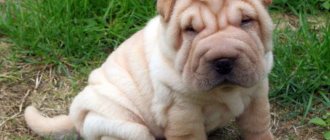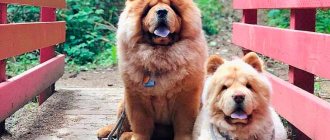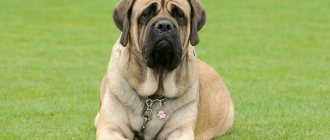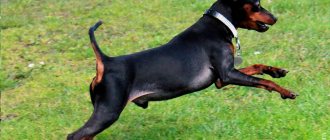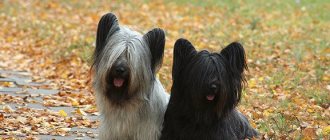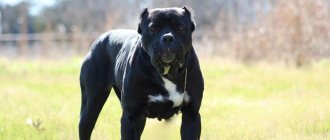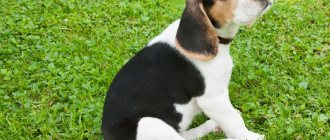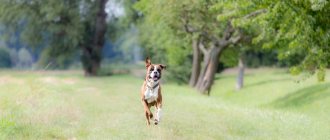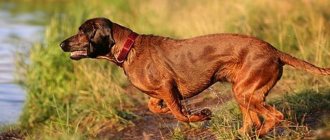History of the origin of the breed
The Shar Pei dog is a native Chinese: the birthplace of the breed is the city of Dailak. Dog figurines with recognizable characteristics were found during excavations of buildings, the construction of which archaeologists date back to the 3rd century BC. This breed is believed to have common ancestors with the Chow Chow and Mastiffs.
Shar-Peis bred to participate in dog fighting are adapted for defense and attack : powerful jaws are capable of inflicting serious wounds, folds on the body and head do not reduce mobility, but protect from injury, prickly hair causes discomfort to the opponent when bitten.
The history of Shar Peis goes back more than three thousand years. During this time, they managed to try out security, guard and hunting functions. Fighting dogs were used in hunting large game that was ready to fight for life: wolves, wild pigs, and feline predators.
Gradually the breed became popular pets. They were equally loved to be kept both in the houses of the nobility and in the huts of peasants. They hunted with dogs, guarded livestock and property.
The ancient ancestors of Shar Peis were distinguished by high intelligence, strength, distrust of strangers, and endurance. Such qualities were passed down from generation to generation and over time transformed into a universal service dog, equally good at guarding the house and hunting big game.
There was a fashion for Shar-Peis among the upper class. They basked in the houses of nobles, served with the equanimity of a monk at temples, and were endowed with royal powers in the imperial palaces.
This continued until the 13th century. Then the empire became mired in wars and conflicts. Breeding has become an unaffordable luxury. At the end of the 18th and beginning of the 19th century, interest in Shar Peis reappeared, but the coming to power of the Communist Party in the mid-20th century almost put an end to the existence of the breed.
Animals were mercilessly destroyed - yesterday's peasants, who stood at the helm of power, considered pets a symbol of the aristocracy. Several dogs ended up in the United States at this time; a few Shar Peis remained on the island of Taiwan and Macau.
In the 1970s, a sad entry appeared in the Guinness Book of Records: “Shar Peis are the rarest dog breed in the world.”
American dog breeders, in an attempt to preserve the breed, were forced to resort to mixing Shar Peis with related breeds and inbreeding.
The American Kennel Association registered the restored breed as the "Chinese Fighting Dog" in 1971 and adopted a standard in 1976. Five years later, Shar Peis were recognized by the International Canine Federation.
Similar breeds
There are several dog breeds that look very similar to the Shar Pei.
- Pug. These dogs have the same folds and curved tail. They differ only in their flattened muzzle and small size, which is only thirty centimeters. Color black, silver or apricot with a black mask. They are also smart and good companions.
- Bloodhound. This breed is very similar to the Shar Pei. Distinctive features are hanging ears and a straight tail. The coat color is black with yellow-brown spots, red-brown or solid bright red. The coat is hard and short. The character is good-natured and kind without aggression.
- English Mastiff. The drooping eyebrows on the eyes and everything else resembles a Shar Pei. But mastiffs are much larger. The height at the withers reaches seventy centimeters. The coat is thick and short, and can be brindle, silver, fawn, or apricot. Mastiffs are majestic, friendly and tolerant.
- English bulldog. This breed is not so graceful, but when you see the folds on the body of bulldogs, you immediately remember Shar-Peis. These dogs have short hair. Its color can be white, red, piebald. Bulldogs are lazy, do not tolerate loneliness well, are good friends, and smart.
We suggest you read: Tag jokes about cats
Shar Pei: description of the breed and character
The Shar Pei dog breed has a distinctive appearance: strong animals with a folded body and head, dark jaws and tongue. What this breed looks like is known all over the world.
The characteristics of the Shar Pei give it a “plush” appearance, but don’t be fooled by first impressions. The breed, which has carried out guard and fighting functions for several millennia, cannot transform into “lap dogs” by changing its characteristics.
Over the course of many years of history, Shar Peis have developed vigilance and distrust of strangers. Calmness and independence are also inherent in these pets.
Playfulness and splashing delight should not be expected. Even if the owner has returned home after a long absence, the dog will wait for attention, but jumping around, wagging his tail, is beneath his dignity. But the affection is sincere.
He will be jealous if his owner's attention is directed to someone else. Shar Peis are attached to all family members, but many of them are monogamous, choosing only one person and recognizing him as the leader.
Representatives of the breed love affection, but will not ask for it. They are easy to learn, but can also show a love of freedom, stubbornly refusing to follow commands. Sensitive to the owner's mood. Quite mobile, energetic, smart. Shar Peis can come up with entertainment themselves and try to impose it on others.
Description of the breed
Unfortunately, today mini-pei do not yet have their own standard - individuals must meet general requirements. They are distinguished from standard representatives of the species only by their height. Moreover, the difference can be only 1 cm. The height of a standard Shar-Pei varies between 44-51 cm, and individuals with a height of 43 cm and below are considered mini-Pei. The most optimal indicator is 35 cm, the minimum is 28 cm. Weight is not specified; if the proportions are observed, miniature individuals have shorter limbs than standard ones.
Otherwise, the dwarf Shar Pei retains the appearance and parameters of the breed representative:
- the head is large, wide, without narrowing towards the muzzle;
- the nose is wide, with well-opened nostrils;
- there is a breed feature - the palate and tongue are colored blue or lavender, in some dogs they may be covered with pink spots;
- the chest is powerful, wide;
- the eyes are small, oval, with a dark iris; the description of the gaze often consists of the following adjectives - sad, serious and even stern - this is what makes it so because of the folded skin hanging over the forehead;
- the ears are set high, fleshy, rectangular, the tips are rounded;
- limbs are widely spaced, stand parallel to each other, with strong bones and developed muscles;
- the tail is set high, curled in a ring and lies on the back.
All Shar-Peis have a compact, almost square build, the back is muscular, the loin and croup are strong. Thanks to mutational changes in genes, dogs of this breed have acquired unusual, folded skin.
Coat and possible colors
There are three types of Shar Pei coat:
- Khorsovaya. A short, hard awn, the length of which does not exceed 1 cm. This is exactly the kind of hair that representatives of the breed had before breeding work.
- Brashevaya. As a result of the addition of new blood, dogs were obtained with a awn length of 1 to 3 cm. Thanks to this coat, individuals look more powerful and strong. They are not recognized at home in China.
- Bear fur. Length no more than 3 cm, passed on to offspring only if both parents have a recessive gene of this type. Not included in the standard.
As for colors, there are dogs with black, fawn, red, cream, sable, blue, lilac, and isabella hair. Dogs with dilute colors are popular - chocolate, red, cream, Isabella.
Albinos, spotted and black-backed dogs are culled.
Character
When looking at the serious face of the mini-pei, it may seem that this is a sad dog who is of little interest to those around him. But any owner of such an unusual dog will say that his pet is the most cheerful, loving and tactful representative of the canine world. It should be borne in mind that the miniature Shar Pei is not without stubbornness and willfulness - qualities inherent in standard dogs. Already from the age of 3 months, the puppy begins to figure out what place it occupies in the house and whether the owners want to make room on the hierarchical ladder. It is important to take into account the dog’s character and not miss the moment of initial education.
You should not expect 100% obedience - the pet will not obey younger family members and older relatives, since their social status is lower than that of the owner. These dogs get along with children, but do not allow unnecessary liberties, therefore, you should not take the puppy to a house where there are children. And in any case, the child should be explained how to communicate with the animal and what actions are best avoided. The Mini Shar Pei needs a person who has a strong character, steadfastness and patience.
Pei have a well-developed protective instinct, therefore, they are wary of strangers. The dog will not announce the entire neighborhood with loud barks, sensing the approach of strangers, but will greet you unkindly. He can live amicably with other pets in the same territory, but only if he grew up with them. A feature of Shar Peis is weakened peripheral vision associated with voluminous eyelids. Because of it, dogs are afraid of sudden touches.
Suitable nicknames
As a rule, offspring that have parents with a pedigree receive a name upon registration and the baby goes to the new owners with it. If a puppy is bought from random sellers, then the owners have to come up with a nickname.
The following nicknames are suitable for boys of this breed: Archie, Acker, Butch, Bruno, Barney, Bingo, Bruce, Dexter, Diego, Joker, Zeus, Cain, Kurt, Cosmo, Lucky, Leo, Monty, Oscar, Pike, Punch, Roni, Reiko , Rolf, Sancho, Simon, Snack, Spikey, Theo, Hulk, Hugo, Charlie, Chet, Juan, Howe, Khaki.
Breed standard
The height and weight of an adult dog depend on gender. The size and weight of males is greater than that of females.
Height at the withers : males - about 50 centimeters, females - about 45 centimeters.
Weight : dimensions also differ depending on gender: males - about 25 kilograms, females - about 22 kilograms.
Life expectancy : from 8 to 12 years.
Head : large, and the folds visually increase it. There is a pendant on the neck. Wide and smooth skull. The wide muzzle does not taper towards the nose. There may be a bump located at the base of the nose.
Nose : large, well developed nostrils. Usually dark in color, but a lobe that matches the color of the coat is also allowed.
Jaws : Well developed, with a precise scissor bite. The tongue, gums and palate are bluish-black. Pink spots on the tongue are acceptable, but a predominant pink color is not acceptable in purebred dogs. Representatives of the breed, whose color does not contain black pigment, have a lilac tongue color.
Eyes : almond-shaped. The iris is dark. Light shades are acceptable in dogs whose color does not have black pigment. Folds on the face or fur should not cause irritation.
Ears : small, dense, triangular, set high. The tips are rounded and hang forward. Prick ears are not acceptable.
Neck : very strong, medium size, without many folds.
Back : smoothly curved, strong, loin – short. Adult dogs should not have folds on the body, except at the withers and base of the tail.
Chest : voluminous, reaching to the elbows.
Belly : slightly tucked.
Tail : set high, thick. It twists into a ring or bends over the back. No or very short tail is unacceptable.
Limbs : straight, parallel, strong, with developed muscles. The paws are compact.
Coat : short, hard, straight. Shar Peis have several types of coat.
Color : any solid color, except white. The tail and the area under it may be slightly lighter than the main color, and the spine and ears may be darker.
Description
The Miniature Shar-Pei is not classified as a separate breed by any kennel club. The Mini Shar Pei was bred from the recessive Shar Pei gene, i.e. The runt of the litter was bred from the litter run to create a smaller specimen.
Appearance
The appearance and shape of the breed can be described as broad and area in proportion to the height and length of the body. Their physical attributes are the same as their larger counterparts, having a large head, a wide soft muzzle, high-set ears, a blue black tongue, and a wrinkled head, neck and shoulders.
https://www.youtube.com/watch?v=ytabout
Dogs of this breed can be of several types. They have many similarities with each other, but there are also differences.
A distinctive feature of Shar-Peis is their tongue, which is lavender or dark purple.
Chinese
AdultPuppy of rare sable colorYoung Chinese Shar-Pei
The Chinese Shar Pei is a fighting breed of dog. The peculiarity of this breed is its wrinkled skin. The puppy has a large number of folds covering its entire body. An adult dog has such folds mainly on the face and neck. The first irregularities are observed on the third day after birth. By the age of one month, seven of them appear.
A puppy who is three months old looks ridiculous, but then most of the wrinkles smooth out.
The color of the coat can be monochromatic or slightly diluted, darkening the face and back, and on the remaining parts it acquires a lighter shade. The coat is short, stiff, sometimes soft, lilac, blue, chocolate, fawn, red, cream, apricot or sable. The character is majestic, restrained. Shar Pei are good guards and do not harm children.
American
Adult American Shar-PeiAmerican Shar-Pei of interesting colorBlack puppy
The Shar Pei of this breed was revived by American cynologists, using single individuals of the ancient Chinese fighting dog as a basis.
The American breed has a more elongated head shape, a not too large nose, and fewer folds than the Chinese. The upper lip does not hang so low over the lower lip.
Larger body size, long legs. The coat is coarse and short. Black color is a sign of the American variety. There are monochrome dogs. They are also loyal and affectionate to their owner. There is a mistrust of others, so proper training is needed.
European
Male European Shar Pei Female European Shar Pei Puppies of this breed
This breed was bred in Europe. Outwardly it looks like a Chinese one. But his character changed and became similar to the English.
Through selection and crossing, these dogs turned out to be even calmer and without aggression at all. They are leisurely and move little.
We suggest you read: What does brown dirt in a cat’s ears mean? Brown dirt in a cat’s ears means ear care
Security skills have become dull. The color can be varied. The body became smaller, changing from a square shape to a more rounded one. This once again emphasizes a sedentary lifestyle. They are phlegmatic and prefer walks at a leisurely pace.
Mini (dwarf)
Mini Pei PuppiesYoung Adult Dwarf Shar Pei
The Mini Pei was born from standard Shar-Peis, but did not reach the required height, which does not exceed 43 centimeters. The rest of the body structure is the same as that of other representatives of the breed. The coat of the small Shar Pei has a variety of colors.
They are distinguished by leadership qualities and are playful. They can show aggression towards other animals. They are loyal to their owner, but can be disobedient, so they need to be raised correctly. If given due attention, they will not cause any problems and will grow up caring and balanced.
The Mini Pei has Plembrac "status" and should not be used for breeding.
Other types
Shar Pei bear puppiesTypical representatives of this breedAdult
Bear is the name given to Shar Peis, which are very similar to bears. The similarity is expressed in the long, soft and shaggy coat. They look more like chow chows rather than the Chinese variety. Chow chows have passed on the gene for long hair, but because of this, bears cannot participate in exhibitions. The coat color is the same as that of other Shar-Peis. The character is playful, quick-witted.
At dog shows, dogs are divided into different varieties. But more often they prefer Chinese Shar-Peis because they fit the standard.
Pros and cons of the breed
If you decide to become the owner of a plush pet, it is better to familiarize yourself with all the advantages and disadvantages in advance.
Pros:
- Memorable appearance.
- Many possible colors.
- Peacefulness and kindness towards “our own people”.
- Unconditional devotion.
- Sharp mind and learning ability.
- Suitable for keeping in an apartment.
- It does not require special care.
- Calm.
- Performing security and watchdog functions.
- Good attitude towards children if the acquaintance took place in puppyhood.
Minuses:
- Jealousy and tendency to remember grievances.
- Tendency to a large number of diseases.
- A “steady hand” is needed, otherwise the dog will become uncontrollable.
- Slowness when following commands: the dog first decides whether it makes sense to do something.
- Tendency to food allergies.
- The folds on the muzzle narrow the view, so sudden movements can lead to either fear or aggression.
- Relationships with other pets will most likely not work out.
Maintenance and care
Of course, if a standard dog can reach sixty centimeters at the withers, then a mini-pei with its forty-two centimeters will seem like a mini version. The smaller the dog turns out to be, the better it will be for him to live in an apartment, since he will always be able to find a place for himself. Clean your ears and wash your eyes regularly. requires special attention .
Skin care is a must. Clean between folds and keep skin dry. Moisture should not stagnate there, as it promotes the growth of bacteria. When walking in the cold season, your dog should be dressed warmly. It does not have a protective undercoat, and the dog will quickly get sick from hypothermia. For rainy weather, add a raincoat to your pet's wardrobe.
They are prone to food allergies, so the food should only be of a high quality, but this does not guarantee that an allergic reaction to any ingredient will not occur. When choosing natural products for your pet’s diet, it is better to consult a professional or seek help from a veterinarian.
Types of Shar Pei
Branches separated from the original Chinese breed, where breeders added something of their own to the appearance:
- Chinese Shar Pei . A traditional Shar Pei whose roots go back to the fighting dogs of Ancient China. The FCI breed standard was written specifically from this variety.
- American Shar Pei . A descendant of Chinese representatives brought to the New World in the mid-20th century. Longer paws, the animals themselves are taller and have fewer folds. Usually black.
- Bear . Long-haired representatives of the breed appeared after the mixing of Shar Pei and Chow Chow blood, during the restoration of the breed in the USA.
- English (European) Shar Pei . It is similar to the Chinese in appearance, but the body is elongated, the character is “English”: calm to the point of phlegmatic, flexible, obedient. Security skills are practically non-existent.
- Mini Shar Pei . The Mini Shar Pei breed is based on the genetic disorders of the Shar Pei. These dogs are smaller than specified in the standard. Mini Shar Peis can be born from purebred individuals with a pedigree. Many people liked the compact version of the breed, so amateur clubs have appeared all over the world, and the breeding of small Shar-Peis is carried out professionally.
From time to time, new attempts are made to modernize the breed: Shar Peis are crossed with shepherd dogs, terriers, Labradors and other species. But the results of such confusion are not recognized. Belgian, Dutch, German and other Shar-Peis do not exist.
Another important detail: the breed standard does not specify any species or types of Shar Pei. If a dog does not match the description, it is not allowed to participate in shows or competitions.
Métis
To obtain mixed breeds, two different breeds of dogs are crossed. Shar Peis have many similar crosses.
Most mestizos are born very smart and easy to train.
Labrador mix
This kind of crossing is at the beginning of the journey and is quite rare. Externally, the dog resembles a Labrador, only with folds. Especially on the face. The color will be solid, the color may be different. The size turns out to be something average. Less Labrador, but more Shar Pei.
This mixed breed is resistant to genetic diseases. By nature, he is more likely to be a companion who gives love than a guard.
With a shepherd
This is a more popular crossbreed. With its body structure, short hair, and wide muzzle, the dog resembles a Chinese ancestor. Height is about fifty-two centimeters. But the color, like that of a shepherd, has a zonal pattern. Also, a shepherd dog can cause damage to its sickle-shaped tail and erect ears.
The dog is very smart and easy to train. But she is quite willful, so she needs a trainer with a strong character.
Most often, the Shar Pei is crossed with the German Shepherd.
Caucasian, Central Asian and Eastern European breeds are not in great demand due to possible genetic problems.
With a pit bull
It is impossible to say for sure which parent the puppy will resemble. Genes are unpredictable. A mixed breed can grow tall, with a pitbull face, or vice versa, shorter than a Shar Pei. The coat color is varied: black, brindle, sand. But most dogs have a black mask on their face.
Their body is muscular and may have folds.
From an early age, such mestizos have a wayward character and will listen to few people.
To prevent them from showing aggression, they need a strict person who will educate them.
We invite you to familiarize yourself with: German Spitz (50 photos): large and small, what an adult dog looks like, miniature French, what are the sizes of puppies, video
With Stafford
This type of crossing is not very common due to genes. In childhood, the mixed breed looks like a Shar Pei due to the presence of folds. As an adult, he becomes similar to the Staffordshire Terrier. The height is about fifty centimeters, like the Shar Pei. Weight about 30 kg. In this way he is like a second parent.
The character is quite problematic, because at the beginning the animal will be affectionate and friendly, and then will begin to show aggression
. An experienced dog handler can help deal with this problem.
With a mongrel
It is impossible to predict what a mongrel cross will look like.
In most cases, dogs grow to be medium in size with large muzzles. There will be folds. The color can be varied, for example, sand color. The coat is short and smooth.
Character is friendly and playful. Such dogs are smart, quick-witted, and calm. They are very loyal to their owner and quickly learn the rules of behavior.
Shar Pei is a breed that is in demand. They are calm and intelligent. There are several varieties from which you can choose a puppy to suit your taste. But in the absence of such opportunities, you can always take a mestizo. They are no worse than purebred dogs if they are given enough attention and raised correctly.
Main types of colors
The standard states that the color of the Shar Pei can be any solid color except white. Experts distinguish two types of color: basic and diluted (weakened). The main colors have a black pigment; these dogs usually have black pigmentation on the face. Dilute colors - without the presence of black.
- Basic : black, red, fawn, cream, blue, isabella, sable.
- Diluted : chocolate, red, cream, apricot, isabella, lilac, sable.
Care and maintenance
The quality of life of your pet directly depends on proper maintenance.
Nutritional Features
When buying a puppy, it is better to feed him what he ate in the kennel. Switching to another food is always stressful. New foods must be introduced into the Shar Pei's diet very carefully: their tendency to food allergies requires caution. One new component per day, in a small portion, and then monitor the baby to see if a problem appears.
The breed's tendency towards food allergies requires caution!
If the diet consists of dry food, it should be hypoallergenic - based on fish, turkey, lamb or calf. The amount of protein is no more than 21%.
If the puppy eats natural products, you need to exclude pork and chicken from the menu. Turkey, lamb or beef mixed with raw or cooked vegetables can be given. Rice or buckwheat porridge with water or broth will complement the diet. It is advisable to give eggs and sea fish at least twice a week.
Vitamins and nutrients are supplied in large quantities by cottage cheese with natural yogurt or low-fat kefir.
Fatty, fried, smoked, and highly salted foods are completely contraindicated. You should not give your dog foods with dyes or preservatives.
Shar Peis are prone to being overweight. The amount of food should be limited. Begging for food at a common table must be stopped immediately.
Attitude towards children and others
Representatives of the breed will get along with older children and will take part in games and walks. Of course, training is needed, not for dogs, but for teenagers. It is imperative to tell that Shar-Peis do not tolerate sudden movements, insults, or injustice. If you follow simple rules, a puppy of this breed will become a wonderful companion.
Shar Pei fur can cause allergies in people. It is advisable to visit the nursery with the whole family before purchasing to avoid problems.
The situation is worse if the child appears in a family where a Shar Pei already lives : it is difficult for the pet to accept the appearance of a new family member. And if you consider that these animals perceive sudden movements as aggression, coexistence with small children becomes a problem.
Shar Peis see dogs as competitors and will not miss an opportunity to find out who is stronger. Hunting dogs with a long history perceive other pets as legitimate prey. Only proper early socialization will help to avoid such an attitude. A socialized puppy will easily get along with other dogs, cats, and birds.
Health and illness
Shar Peis are prone to many diseases. Unfortunately, this breed cannot boast of good health. Here are the most common diseases:
- dysplasia of the elbow and pelvis – the joints are partially or completely destroyed;
- knee dislocations – the kneecap dislocates;
- osteochondrosis – a problem with cartilage;
- Shar Pei fever – swelling of the hock joints;
- hypothyroidism – dysfunction of the thyroid gland;
- seborrhea – a disorder in the process of formation of substances in skin cells;
- demodicosis - skin problems caused by mites;
- pyoderma is an infection that affects the skin;
- cutaneous mucinosis - too much mucin in the skin;
- otitis – inflammation of the ear canal;
- Gastric volvulus – the stomach twists around the esophagus;
- Entropion is an incorrect position of the eyelids.
Vaccination is necessary. During puppyhood, comprehensive vaccinations are needed to protect against common diseases. The first is done at 8 weeks of age, the second at 10 weeks. At about six months of age, a rabies vaccination is given. Adult dogs need to be vaccinated annually.
Representatives of the breed cannot be called long-livers. Shar Peis live from 10 to 12 years.
Education and training
People who do not have experience in dog breeding should better pay attention to other breeds: Shar Peis strive for leadership. To build the right hierarchy, you will have to combine a firm hand and a respectful attitude. Finding this balance is difficult. Representatives of the breed will unquestioningly obey only the one who is recognized as the owner and leader.
It is prohibited to use physical force on Shar Peis. Such “methods” will lead to one of the extremes: the dog will be either intimidated or aggressive.
Shar Peis have a unique concept of justice. They will not follow rules that are ignored by other family members. If you loosen your control a little, the dog will try to go beyond what is permitted.
You cannot indulge the whims of even a charming puppy. Early socialization is a necessity. If acquaintance with the outside world is not carried out, aggression towards strangers and animals will most likely come out. Unreasonable anger also needs to be limited, and the pet must be taught restraint and decent behavior.
Fighting dog or not
One of the common questions that arises among people who read the history of the breed. Participation in dog fighting is a thing of the distant past. The dogs managed to retrain as hunters and watchmen, and the intervention of breeders finally freed the Shar-Peis from their bitterness.
The hot temper and hostility towards strangers are the result of security, not fighting functions. Therefore, despite the name “Chinese Fighting Dog” registered in the USA, modern Shar Peis are not suitable for the role of a fighter in the ring.
How much does a Shar Pei cost?
The cost of a Shar Pei depends on its physical condition, pedigree, appearance, and the brand of the nursery.
- Ordinary dogs for home keeping will cost the new owner approximately 15,000 rubles.
- Pedigree puppies with a pedigree and documents will cost from 25 to 30 thousand rubles.
- The price for puppies from champion parents, with pronounced characteristics of the breed, starts from 50 thousand rubles... and there is no limit to perfection.
If you decide to get a plush puppy, check out the various options for names for Shar Pei.
How long do Shar Peis live?
With normal care and the right lifestyle, these dogs can live up to 10 years, and sometimes longer. The average life expectancy of representatives of this breed is not very high, but for average dogs it is a good indicator.
In order for your pet to be healthy and live a long and happy life, it needs to eat properly and walk long enough. If a person is going to get a Chinese Shar-Pei, he must understand that this dog is very active, and it will not be enough for him to walk 10 minutes a day. Moreover, the folds of the animal's skin can also become a problem. They need to be properly cared for and periodically washed and wiped to prevent dirt from accumulating there, which can cause inflammation.
We invite you to read: Instructions for use of the veterinary drug Covinan
Interesting Facts
- The poetic inhabitants of Ancient China claimed that the Shar Pei once licked the sky, which is why its tongue was blue.
- The inhabitants of the Middle Kingdom are superstitious, so the dark color of the tongue and palate of the Shar Pei seems to them to be a sufficient reason to claim that such dogs are capable of driving out evil spirits.
- American breeders, working to restore the breed in the 1970s, were able to find only ten individuals throughout China. It was these dogs that gave rise to modern Shar-Peis.
- The French are connoisseurs of this breed of dog, and their sense of humor has led to the adage: “If you take a Shar Pei with you to a meeting with friends, don’t be surprised if you go unnoticed.”
Standards
If the usual size ranges from forty-four to sixty centimeters, then the mini version is a height at the withers of up to forty-three centimeters. Other standards are retained:
- The head is large and wide. There is no narrowing towards the muzzle.
- Well developed chest.
- The eyes are small in size, in the shape of a slightly elongated oval. The iris is always dark in color. The expression in the eyes is sad.
- The ears are thick, rectangular, set high, spaced wide apart. The tips of the ears are slightly rounded, directed towards the eyes.
- Limbs straight, parallel, widely spaced.
- The body is compact, almost square in shape.
- The nose is wide and open nostrils.
- The back is straight.
- The tongue and palate are blue or lavender in color. Blue color with pink spots is also allowed.
- The tail is curled into a ring and lies on the back. A distinctive feature of Shar-Peis is their high tail set.
- But the main feature is the folding of the skin. This is caused by a mutation in the HAS2 gene.
- The coat is short, lying close to the body. It is divided into three types: “bear hair”, horse and brush.
- The color palette is quite extensive; they are divided into a group in which black pigment is necessarily present, and a group in which color is completely absent.

